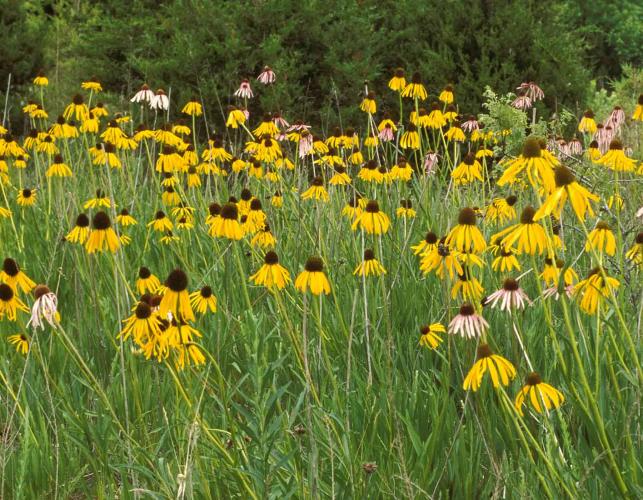
Yellow coneflower is a perennial with an unbranched stem arising from basal leaves, with a single flowerhead. Disk flowers with spiny bracts. Ray flowers drooping, yellow, 1½–3½ inches long, notched at the tips. Basal leaves in a clump, strap-shaped, up to 8 inches long including stalks. Stem leaves shorter and lacking stalks. Fruits in a burlike, dome-shaped head, blackening on drying.
Similar species: Our other coneflowers all have ray flowers that are pink or purplish pink. This is the only one with yellow ray flowers; this curious trait explains the species name, paradoxa. This species apparently sometimes hybridizes with other coneflowers. Hybrids usually have mottled or variegated ray corollas that can be a mix of pink and purple or may be orangish. Look for these in sites where yellow coneflower grows nearby the other species.
Height: to 3 feet.

Scattered mostly in the western half of the Ozarks and Ozark Border regions. Cultivated statewide.
Habitat and Conservation
Grows in limestone and dolomite glades, balds, upland prairies, and savannas; also along roadsides. This species is nearly endemic to the Ozarks; that is, it occurs only in the Ozarks and no where else in the world. Like other members of its genus, it is targeted by root collectors who vandalize high-quality glades and prairies in public lands so they can sell the roots.
Status
Native Missouri wildflower.
Human Connections
Missouri coneflowers are threatened by harvest for the medicinal herb market. Although coneflowers are easily cultivated, illegal and unethical root digging continues despite decades of studies failing to prove that echinacea supplements are medicinally effective.
Ecosystem Connections
As with other coneflowers, the flowers of this species are attractive to bees, butterflies, and other insects. Late in the season and continuing through winter, finches eat the seeds from the spiny-looking, spent flowerheads. Rodents eat seeds that fall to the ground.





































